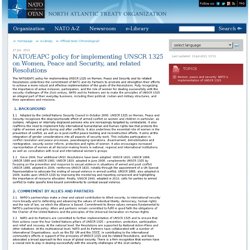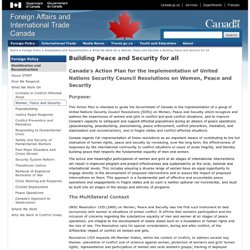

Dossier du ROP La mise en oeuvre de la résolution 1325(2000) : quels progrès pour les femmes, la paix et la sécurité ? 19 déc. 2012 Les violences polymorphes subies par les femmes et largement décriées en période de conflits et de post conflits ne datent pas d’aujourd’hui.

Elles sont prises pour cible à tous les niveaux : mental, sexuel, physique et cela, malgré l’existence d’un cadre juridique de la protection des femmes[1] ainsi que des documents[2] légaux antérieurs. En adoptant la résolution 1325 en date du 31 octobre 2000 lors de sa 4213éme séance, le Conseil de sécurité de l’ONU a souhaité que des mesures ciblées et concentrées visant à prévenir les conflits et les violences, l’exploitation et les sévices sexuels et sexistes soient prisent à l’encontre des femmes et des filles. La résolution vise également l’approche genre dans les conflits pour une pleine et égale participation des femmes dans la prévention, la gestion, la résolution des conflits ainsi que dans le processus d’édification de la paix et de la reconstruction post conflit.
Coordination et responsabilité en matière de résultats. Task Force on Women, Peace and Security. National implementation of Security Council resolution 1325 (2000) UN Security Council resolution 1325 (2000) recognizes the importance of promoting gender equality and the empowerment of women in order to achieve the goals of peace and development, and emphasizes the critical role Member States can play in that respect.

It urges Member States to take action at the national level in the following key areas: United Nations Entity for Gender Equality and the Empowerment of Women. What is U.N. SCR 1325 and Why is it so Critical Today? In 2000, the United Nations Security Council formally acknowledged through the creation of Resolution 1325 the changing nature of warfare, in which civilians are increasingly targeted, and women continue to be excluded from participation in peace processes.
UNSCR 1325 addresses not only the inordinate impact of war on women, but also the pivotal role women should and do play in conflict management, conflict resolution, and sustainable peace. This tutorial provides a broad overview of the United Nations Security Council Resolution 1325 on women, peace and security, including its significance and its content. The tutorial also draws upon USIP publications, tools, and multimedia to provide concrete examples and incorporates links to outside resources for additional exploration into this topic. | Return to the Gender and Peacebuilding Center >> What is U.N.
Security Council Resolution 1325? >> Why did the U.N. >> Why do women need to be critical actors in peace building? What is U.N. I. II. Official text: NATO/EAPC policy for implementing UNSCR 1325 on Women, Peace and Security, and related Resolutions, 27-Jun.-2011. 27 Jun. 2011 The NATO/EAPC policy for implementing UNSCR 1325 on Women, Peace and Security and its related Resolutions underlines the commitment of NATO and its Partners to promote and strengthen their efforts to achieve a more robust and effective implementation of the goals of the Resolutions.

Fully recognizing the importance of active inclusion, participation, and the role of women for dealing successfully with the security challenges of the 21st century, NATO and its Partners aim to make the principles of UNSCR 1325 an integral part of their everyday business, including their political, civilian and military structures, and their operations and missions. Review: Women, peace and security. Secretary General releases annual report on women, peace and security, 15-Jan.-2013. 15 Jan. 2013 The Secretary General detailed the Alliance’s efforts over the past year to implement United Nations Security Council Resolution (UNSCR) 1325 in its operations and activities in his second annual report on this issue, which was released on Tuesday 15 January.
Adopted in 2000, the Resolution recognizes the disproportionate effect of armed conflict on women and children. All NATO Allies and partners are committed to ensuring that gender considerations are integrated into security work. “Achieving greater empowerment and more effective protection of women against the specific dangers they face in armed conflicts is of benefit not only to women, but to us all,” says Secretary General Anders Fogh Rasmussen. “In our work we are more systematically implementing NATO policy and directives through our planning, exercising and training activities.
Women, Peace and Security. Modern conflict no longer respects the line between the military and the civilian.

Building Peace and Security for all. Canada's Action Plan for the Implementation of United Nations Security Council Resolutions on Women, Peace and Security Purpose:
